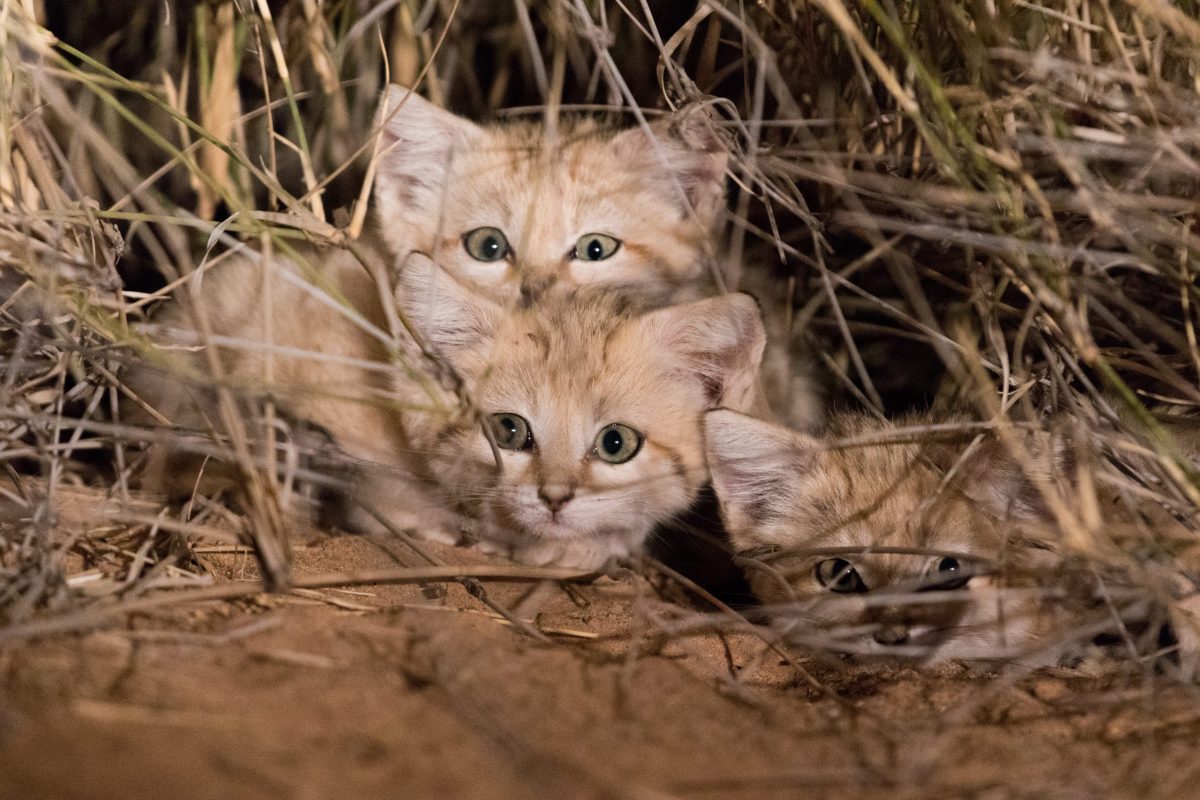The Saharan Sand Cat: A Tiny Feline Capable of Great Feats
Posted on Categories Discover Magazine

It’s a quiet and cold night in the Moroccan Sahara, with temperatures dipping into the 40s. This isn’t the romantic image of the desert you might imagine — no mile-high dunes, soft sands or dromedaries traversing the landscape.
Here, the desert is stony and flat with hard-packed gravel, dotted with periodic dry bushes and the occasional sheep herder. Far from any water sources, this part of the world may not see rain for several years.
Surviving in these harsh environments is a small, unassuming feline. While resilient and able to travel extreme distances, this cat may also distract you with its cuteness.
What Is a Sand Cat?
(Credit:Grégory Breton/Panthera)
Meet the Saharan sand cat. It looks like a permanent kitten at about half the size of a domesticated cat with pale grey fur meant to camouflage it in the desert. It has a “soft disposition,” never aggressive or hissing as other small cats might. It’s equally tolerant of other sand cats, not often territorial when they share the same home range.
Ecologist Alexander Sliwa has spent his career studying the sand cat, determined to better understand and protect an animal that’s long been misunderstood. “I was 11 years old when I saw my first sand cat in a zoo in Berlin,” says Sliwa, who’s also curator at the Cologne Zoo in Germany.
Read more: Sorry, ‘Tiger King,’ but Big Cats Don’t Make Good Pets
Where Do Sand Cats Live?
(Credit:Grégory Breton/Panthera)
According to research Sliwa recently published in the Journal of Arid Environments, the sand cat’s home range is so huge that it’s difficult to follow even once it’s equipped with its tiny tracking collar. Sliwa contends that the cat’s 1,093 square mile projected range is likely an underestimation.
While the sand cat may resemble a miniature house cat, it’s the most well-adapted desert cat in the world. Its range is enormous because there are so few rodents to feed on, so it must travel great distances to meet its survival needs. Their vast range makes it difficult for scientists to study, which is part of why we’re only beginning to understand how they live.
“The charismatic little sand cat is well adapted to life in hot deserts and occurs in scattered populations from the Atlantic Sahara eastwards through Arabia to Iran and Central Asia,” says David Mallon, special advisor to the International Union for Conservation of Nature Species Survival Commission (IUCN SSC), who was not involved in the study. “It is one of the least well-known felids, and this new radio tracking study marks a significant increase in our knowledge of its home range size and movements, information that is invaluable for planning conservation measures and as a basis for further research on its ecology.”
But even with high-frequency radio collars, these animals are hard to track because they travel so far that once a cat is located, it’s hard to find that same cat again. Especially considering that much of the land is controlled by the Moroccan military, Sliwa and his team could not travel out of certain areas because of risks outside their control. They also couldn’t use drones to track the animals because of the security risk.
Read more: Cats Ruled These 4 Ancient Civilizations
What Do Sand Cats Eat?
(Credit:Grégory Breton/Panthera)
Some think these cats maintain the largest home range of any feline. It’s part of their quest for survival in an unforgiving landscape, preying on a few scattered rodents like the jerboa and gerbil. “I think in the course of one year, their home range is even bigger than we see here,” Sliwa says.
With the exception of golden eagles and golden wolves, sand cats aren’t preyed upon. In fact, their biggest threat comes from humans encroaching on their habitat. “We have proof that sand cats have been killed by shepherd dogs protecting flocks of sheep, goats and dromedaries,” Sliwa says.
Read more: Cat Lifespan Demystified: How Long Do Cats Live?
How Many Sand Cats Exist?
(Credit:Grégory Breton/Panthera)
One of the key findings from the study is that these animals travel so far that there are likely fewer of them than we’ve previously thought. In the past, when they’ve been counted, scientists were likely counting the same cat more than once because they had no idea how far they traveled.
Sliwa says that this research is just a start. This is the first study of an animal he has loved since he was a boy. It’s an animal that he wants to thrive into the future in a part of the world where human impact is getting worse. “The Sahara has been poached dry,” says Sliwa, and the sand cat has somehow survived up until now. Sliwa wants to protect this miraculous species for years to come.
Read more: 5 Cats Who Owned Famous Scientists